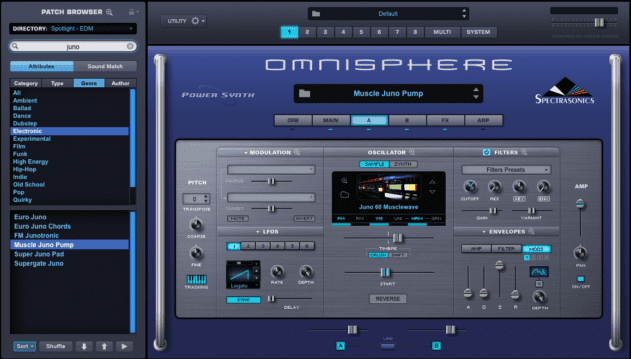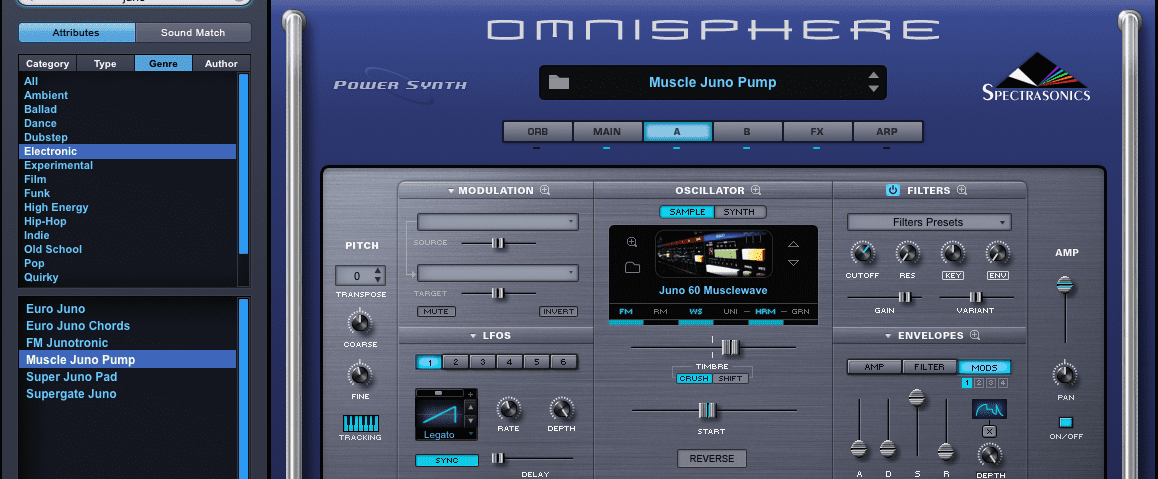With its first major update since 2008, Omnisphere expands to become an even more powerful synth. Greg Scarth explores its extensive options.

In his introduction to the first full update of Omnisphere
since its release in 2008, Spectrasonics Creative Director Eric Persing
claims that “it’ll take a lifetime to explore all the possibilities” of the software. You’d usually dismiss such a hyperbolic claim as marketing hype, but in this case there’s a distinct sense that it might actually be true.
Spectrasonics claim it'll take a lifetime to explore the possibilities of Omnisphere. That might actually be true
Omnisphere is a hybrid synth which is probably best known as a go-to option for soundtrack composers. While there’s still a huge amount of content that will lend itself to cinematic use – dramatic strings, ominous atmospheres and the like – Spectrasonics have broadened the remit substantially for version 2, not only in terms of the styles of sound on offer, but also the synthesis options themselves.
To say that this is a heavyweight synth is an understatement. Omnisphere is supplied on a mere eight DVDs, requiring 64GB of free hard disk space for an installation process that can take up to five hours. The overwhelming majority of that disk space is of course required for sample content. A quick look through the presets explains why it’s such a hefty install: the sheer range of sample-based instruments on offer is almost overwhelming. There are, for instance, 26 different categories (Types, in Spectrasonics-speak) of bell sounds, from Bells Analog to Bells Digital (and a separate Digital Bells category), via more obscure options like Bells Gothic and tempo-synced BPM Bells. The same is true for other categories, with a huge, varied selection of strings, synths, percussive sounds and brass among others. Altogether there are more than 4,500 new patches, bringing the grand total to over 12,000 (the updated areas include a huge new ‘Spotlight – EDM’ library).
At its heart, Omnisphere is a dual-layer synth with sample- or DSP-based oscillators feeding into what can be loosely interpreted as a specialised subtractive synth architecture
Thanks to the extensive preset options, you could almost
be forgiven for thinking Omnisphere was all about presets, but you’d be missing out on the bigger picture. It’s true to say that you could easily spend a good few months doing nothing but auditioning factory patches, but it’s not just a plug-and-play preset machine. Far from it. It’s worth taking a step back and considering how Omnisphere 2’s synth engine works in order to understand what it can do. At its heart, Omnisphere is essentially a highly specialised dual-layer synth with sample- or DSP-based oscillators feeding into what can be loosely interpreted as a subtractive synth architecture. Each of the two layers features two filters, six envelope generators (one for amplitude, one for filter cutoff and four per part for modulation), six LFOs per part and an extensive modulation matrix.
Perhaps the biggest and most impressive updates come in the oscillator section. For each layer, the oscillators can be set to Sample or Synth mode, with the former allowing you to choose from the thousands of built-in samples (‘soundsources’) and the latter offering hundreds of modelled synth waveforms (everything from analogue classics like the Minimoog and Juno-106 through to digital wavetables and analogue ‘timbres’). Omnisphere now also allows you to import audio files as custom soundsources, hugely expanding its potential for creating sample-based instruments, but also tying into synthesis options such as the improved FM and ring mod options, Harmonia and the granular synthesis sections, creating a uniquely powerful synth. It’s a measure of Omnisphere 2’s power, depth and flexibility that we can only really scratch the surface of the synthesis options in a review. Persing’s claim rings true here, with the granular synth option in particular qualifying as a hugely powerful synthesis approach in its own right.
The easiest way to get to grips with the synthesis options in Omnisphere is to start with a preset and then navigate your way around the interface to discover the features. Omnisphere wisely avoids trying to cram everything into a single window user interface, instead choosing to include a handful of key parameters on the main page, with the deeper options hidden behind ‘zoom’ buttons. Zoom into the filter section, for instance, and you get full control of both filters for each layer, with 32 modes available for each. It’s a hugely powerful setup, and again that’s before we’ve even touched upon the less glamorous but equally important options such as the wide range of effects, improved arpeggiator and updated Orb modulation section.
There’s only one major issue with Omnisphere 2, and it’s an obvious one: the cost. At $499, the instrument is priced firmly in the realm of pro sample libraries rather than your typical budget soft synth. That is, of course, fully justified not only by the quality of the product but by the time and effort that must have gone into putting together the giant package of presets (the list of credits for sound design fills nearly a full page of the manual). Nevertheless it’s a shame that it’ll no doubt put off a lot of potential buyers. Omnisphere is a serious investment, there’s no doubt about that, but what you get for your money is a hugely versatile synth paired with one of the most impressively thorough sound libraries you’ll come across. Omnisphere 2 is a vast, immensely powerful instrument created to the highest possible standards.
The Verdict
Price: $499
Purchase: Omnisphere
The Final Word
A truly immense virtual instrument reaches new levels with added features, extra sounds and the expansion of its synthesis options

05.40 AM
One can never have enough bells. 🙂
Although your OVERALL rating was 5 stars, I’d still argue that VALUE should be rated higher than that — when you compare it to other synths costing $100, Omnisphere 2 has far, FAR more than 5 times the usable content… plus everything else you can do with it. It’s truly quality in quantity, crafted by master sound designers. There are very few weak patches amidst many thousands, and though some sound similar or are variations, they’re diverse enough to justify their existence.
The new content in Omnisphere 2 is incredible: the musical stalactites, a comprehensively-sampled Hang/Pan Drum and many variations, an entire collection of kalimbas/thumb pianos, Diego Stocco’s mutant instruments, etc. These aren’t advertised more upfront but when you consider what sample libraries equivalent to some of these cost alone, WOWOWOWOW.
Omnisphere is worth saving up for if you’re serious about making electronic music, it’s in fact a comprehensive time-machine-encyclopedia of the history of electronic music AND THEN SOME. That may be understating it. I remember when I stayed away from it because I found the sheer amount of content too intimidating to absorb, but I’m glad I dove in.
One thing that sets Omnisphere aside from so many others aren’t just the sounds… it’s the metadata that makes the sounds so searchable, plus the new Sound Match to find related sounds. And the 2.1 update makes it even more accessible for 3rd-party patch library creators.
OH YEAH, AND CUSTOM AUDIO VIA USER SOUNDSOURCES *FINALLY*… pump all that through Omnisphere’s deep engine.
However, I’d like some of the UI to feel more modernized and elegant. Would be great to double-click on various values and precision TYPE in numbers instead of dragging them all figety.